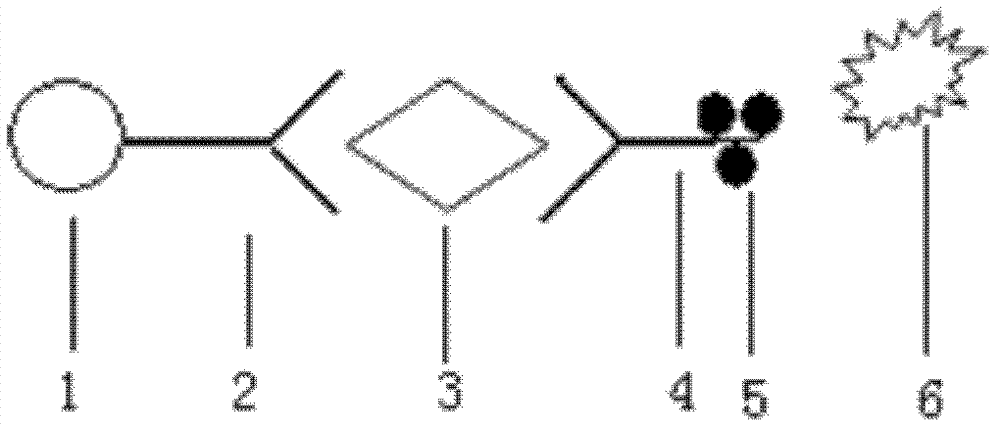Kit for quantitatively detecting GFAP concentration in human serum by polystyrene microsphere
A technology for quantitative detection of polystyrene microspheres, which is applied to measuring devices, instruments, scientific instruments, etc., and achieves the effect of low price, favorable popularization and promotion, and large surface coupling capacity
- Summary
- Abstract
- Description
- Claims
- Application Information
AI Technical Summary
Problems solved by technology
Method used
Image
Examples
Embodiment 1
[0031] Step 1 Preparation of Microsphere Storage Solution
[0032] (1) Activation of microspheres: After the polystyrene microspheres are uniformly dispersed, take 5.0×106 Add 100 μl washing buffer (PBS, 0.05% Tween) to the microspheres, shake at high speed for 15 seconds, suspend the microspheres with 80 μl activation buffer after washing, add 10 μl carbodiimide (EDC, 50 mg / ml), and quickly add 10 μL Sulfo- NHS (50mg / ml), shake at high speed for 30s, shake at room temperature for 20min in the dark, then wash twice with 500μl 0.01M pH7.4PBS, centrifuge at 12000r / min for 3min each time, discard the supernatant, and finally wash with 100μL 0.01M pH7.4PBS suspended microspheres.
[0033] (2) Cross-linking of microspheres: Add 100 μg of anti-GFAP monoclonal antibody to the activated microspheres, dilute to 500 μl with 0.01 M pH7.4 PBS, wrap in tinfoil, shake at room temperature for 4 hours in the dark, 15000 r / min Centrifuge for 5min, discard the supernatant, wash once with 500μl...
Embodiment 2
[0056] 1. The kit for the quantitative detection of GFAP concentration in human serum by polystyrene microspheres consists of 1 piece of 96-well filter plate, 2 bottles of standard products, 1 bottle of sample diluent, and polystyrene with anti-GFAP antibody coupled to the surface Microspheres, 1 bottle of microsphere storage solution, 1 bottle of enzyme conjugate, 1 bottle of substrate A, 1 bottle of substrate B, 20× washing solution, 20 self-adhesive coverslips and 1 instruction manual.
[0057] 2. Application of the kit for the quantitative detection of GFAP concentration in human serum by polystyrene microspheres
[0058] (1) Dilution of the standard product: Dilute each bottle to 1ml with the sample diluent before use, and after standing for 10 minutes, mix it upside down repeatedly. ml, 12.5ng / ml, 3.12ng / ml, 0.78ng / ml, 0.05ng / ml, the sample diluent is 0ng / ml.
[0059] (2) Adding samples: Shake and mix the microspheres at medium speed before use, add 10 μl of microsphere...
Embodiment 3
[0067] Evaluation of the detection kit for the quantitative detection of GFAP concentration in human serum by polystyrene microspheres:
[0068] (1) Linear range: Dilute the GFAP antigen in a 2-fold gradient with the sample diluent to the following serial concentrations: 100ng / ml, 50ng / ml, 12.5ng / ml, 6.25ng / ml, 3.13ng / ml, 1.56ng / ml, 0.39ng / ml, 0.10ng / ml, 0.025ng / ml, 0.013ng / ml, 0ng / ml were tested, each concentration sample was tested 3 times, the abscissa was the sample concentration, and the relative luminous intensity was plotted as the ordinate , after statistical analysis, the linear range is 0.025ng / ml~100ng / ml.
[0069] (2) Minimum detection limit: Divide the GFAP-removed zero-value serum into 20 parts for detection, measure its concentration, calculate the average value and standard deviation, calculate the sum of twice the average value and standard deviation, and detect it on the standard curve The lowest detection line of the present invention is 17pg / ml.
[0070] ...
PUM
| Property | Measurement | Unit |
|---|---|---|
| molecular weight | aaaaa | aaaaa |
Abstract
Description
Claims
Application Information
 Login to View More
Login to View More - R&D
- Intellectual Property
- Life Sciences
- Materials
- Tech Scout
- Unparalleled Data Quality
- Higher Quality Content
- 60% Fewer Hallucinations
Browse by: Latest US Patents, China's latest patents, Technical Efficacy Thesaurus, Application Domain, Technology Topic, Popular Technical Reports.
© 2025 PatSnap. All rights reserved.Legal|Privacy policy|Modern Slavery Act Transparency Statement|Sitemap|About US| Contact US: help@patsnap.com



